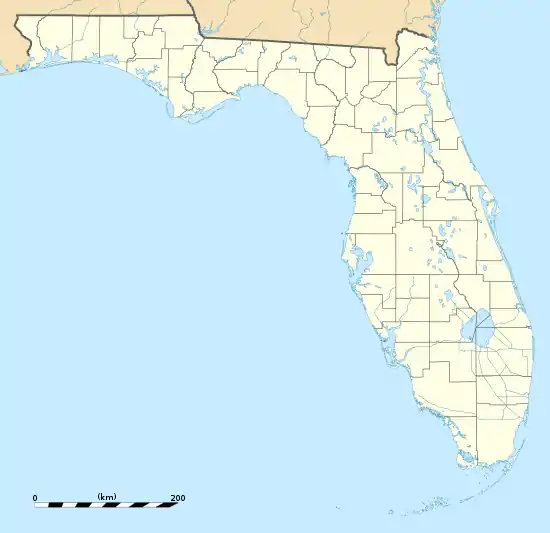Archbold Biological Station
The Archbold Biological Station (ABS) is a research institute with a surrounding 5,192.63-acre (21 km2) estate near Lake Placid, Florida, USA. It includes an extensive area of Florida scrub, a scientifically interesting and highly threatened ecosystem. It was established in 1941 by Richard Archbold when his sponsorship of zoological research in New Guinea was curtailed by the outbreak of the Second World War in the Pacific region. The Station supports 19 federally listed threatened species, including the Sand Skink (Neoseps reynoldsi) and 13 endemic plant species. It is a venue for field research and education.
Archbold Biological Station | |
 Main building at Archbold Biological Station | |
  | |
| Location | Venus, Florida, USA |
|---|---|
| Coordinates | 27°10′50″N 81°21′0″W |
| Area | 5,192.63 acres (21.0138 km2) |
| Built | 1941 |
| NRHP reference No. | 07000698[1][2] |
| Added to NRHP | July 20, 2007[1] |
The station and grounds are open to visitors, who must register at the main office. There are some displays about the property and its history, a video about the biodiversity and conservation of the Lake Wales Ridge, a 1/2 mile nature trail and picnic tables. Nature and environmental education programs are offered for schools, adults and specialty groups.
On July 20, 2007, it was added to the U.S. National Register of Historic Places.[1]
Archbold acquired the initial land for the biological research station through his friend Donald Roebling from his father, John A. Roebling II.[3] Subsequently, additional land was purchased.
Climate
The climate of Archbold Biological Station is classified as humid subtropical (Köppen Cwa), with hot, humid summers and warm, dry winters. Due to its location on the well-drained sandy soil of the Lake Wales Ridge, the station experiences unusually low minimum temps, especially during summer. On clear nights, the dry soil of the scrub allows for quicker radiational cooling than surrounding lowland areas. The record high and record low are 103 °F (39 °C) and 13 °F (−11 °C), recorded on July 4, 1998 and January 5, 2001, respectively.
| Climate data for Archbold Bio Stn, 1981-2010 normals, extremes 1969-present | |||||||||||||
|---|---|---|---|---|---|---|---|---|---|---|---|---|---|
| Month | Jan | Feb | Mar | Apr | May | Jun | Jul | Aug | Sep | Oct | Nov | Dec | Year |
| Record high °F (°C) | 89 (32) |
92 (33) |
94 (34) |
98 (37) |
100 (38) |
102 (39) |
103 (39) |
101 (38) |
99 (37) |
97 (36) |
96 (36) |
91 (33) |
103 (39) |
| Average high °F (°C) | 73.5 (23.1) |
76.5 (24.7) |
80.0 (26.7) |
84.3 (29.1) |
89.4 (31.9) |
91.4 (33.0) |
92.4 (33.6) |
92.2 (33.4) |
90.3 (32.4) |
86.1 (30.1) |
80.1 (26.7) |
75.1 (23.9) |
84.3 (29.1) |
| Average low °F (°C) | 46.5 (8.1) |
48.8 (9.3) |
52.1 (11.2) |
55.1 (12.8) |
61.2 (16.2) |
67.7 (19.8) |
68.7 (20.4) |
69.6 (20.9) |
69.1 (20.6) |
63.0 (17.2) |
56.0 (13.3) |
50.1 (10.1) |
59.0 (15.0) |
| Record low °F (°C) | 13 (−11) |
18 (−8) |
20 (−7) |
27 (−3) |
36 (2) |
50 (10) |
58 (14) |
60 (16) |
55 (13) |
34 (1) |
27 (−3) |
16 (−9) |
13 (−11) |
| Average precipitation inches (mm) | 1.92 (49) |
2.55 (65) |
3.77 (96) |
2.25 (57) |
3.41 (87) |
8.20 (208) |
8.20 (208) |
8.31 (211) |
6.46 (164) |
3.18 (81) |
1.98 (50) |
1.92 (49) |
52.15 (1,325) |
| Average rainy days (≥ 0.01 in) | 6.3 | 6.3 | 7.0 | 6.0 | 7.6 | 15.6 | 15.4 | 16.9 | 14.6 | 7.8 | 6.0 | 6.5 | 116 |
| Source: | |||||||||||||
References
- "Weekly List Of Actions Taken On Properties: 7/16/07 through 7/20/07". National Park Service.
- "National Register Information System". National Register of Historic Places. National Park Service. July 9, 2010.
- Lohrer, Fred E. (July 17, 2017) [2006]. "John A. Roebling, II (1867-1952), Builder of the Red Hill Estate (1929-1941), Lake Placid, Florida" (PDF). Archbold Biological Station. Retrieved October 24, 2018.
Bibliography
- Morse, R. (2000). Richard Archbold and the Archbold Biological Station. Gainesville, Florida: University Press of Florida. ISBN 0-8130-1761-0.
External links
 Media related to Archbold Biological Station at Wikimedia Commons
Media related to Archbold Biological Station at Wikimedia Commons- Archbold Biological Station